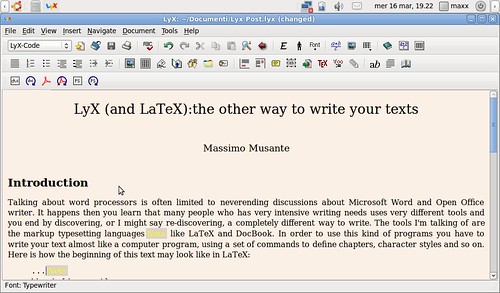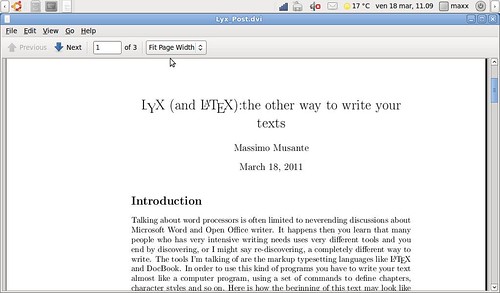Talking about word processors is often limited to never ending discussions about Microsoft Word and Open Office writer. It happens then you learn that many people who has very intensive writing needs uses very different tools and you end by discovering, or I might say re-discovering, a completely different way to write. The tools I'm talking of are the markup typesetting languages like LaTeX and DocBook. In order to use this kind of programs you have to write your text almost like a computer program, using a set of commands to define chapters, character styles and so on. Here is how the beginning of this text may look like in LaTeX:
...\begin{document}\title{\LyX{} (and \LaTeX{}):the other way to write your texts}\author{Massimo Musante}\maketitle\section*{Introduction }Talking about word processors is often limited to never-endingdiscussions about Microsoft Word and Open Office writer. It happensthen you learn that many people who has very intensive writing needsuses very different tools and you end by discovering, or I might sayre-discovering, a completely different way to write. The tools I'mtalking of are the typesetting languages like \LaTeX{} and DocBook.In order to use this...
I had my first experiences with a similar program, Troff, when I was studying (there are few ways to write a document from a green-phosphors VT100 terminal). Learning curve had been quite steep and when new computers with more modern word processors where made available I quickly dismissed these languages as relics from past. After many years I learn that old typesetting languages have evolved, some new has been developed and many people continue using them. I so decided to have a look to the LaTeX universe to understand if it's still a viable way to write your texts and if the learning curve has been some-way made easier. After a brief research on the Internet I discovered LyX, a writing software that promised to make writing a document with LaTeX as easy as using any other word processing application. I so installed LyX, easily from Ubuntu's software center, and started trying it by writing this post with it.
WYSIWYG vs WYSIWYM
Word processing software we are used to know, like Open Office Writer, are usually referred as WYSIWYG (What you see is what you get) since they show you in the screen how your document will appear once printed. by contrast other writing software like LyX has been called WYSIWYM (What you see is what you mean) since what they show you on screen is e representation of document's logical structure (sections, chapters ...) of representing its physical layout. The WYSIWYM concept works great when the content of your text is preponderant above its layout. For example if you're writing a book or an article you're going to use an handful of text styles over all the document but it will be fundamental using them in a consistent way. On the other hand if your are writing documents where layout is preponderant, like leaflets, the better feedback with the document final layout will probably make you save time. The major drawback of using WYSIWYM concept has ever been the steep learning curve of typesetting markup languages ... at least until now.
First impressions
Here is how LyX looks like:
as you can see it, after all, looks not more different than other word processors. The combo menu on the top left will let you choose the text style you are writing with, all the other buttons and menus will let you operate on your document in a very natural way. The biggest difference you may notice is that LyX will not react to any manual formatting tentative (tabs, multiple spaces ...) that's the way LyX works: you just have to type and let the computer handle all layout problems. Must be said that all modern word processors offers all automatic styling options LyX offers, the very difference is that with standard word processors you have to choose to use these features while with LyX this is the most natural way to write. Last but not least the printable output (DVI or PDF format) looks really great.
Conclusions
LyX is definitively a great writing tool that allow you using a complex tool like LaTeX without the need of knowing it. Of course without knowing LaTeX you use LyX only at a little fraction of its capability but this is good enough to start. While I used it, I missed a little some Open Office Writer features like automatic correction of common errors and syntax errors underlining. But this is more because my laziness in writing than a LyX fault. I also experienced some freezing of the spelling check feature.
Am I going to use LyX in the near future? Probably not because my actual writing needs are limited to writing few blog articles and LyX is not very suited for this, even if it can produce HTML output trough the external program elyxer, but after all I might decide to start writing the book of my life ... you never know.




No comments :
Post a Comment